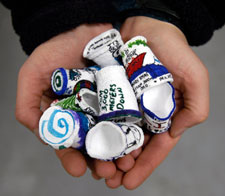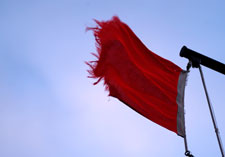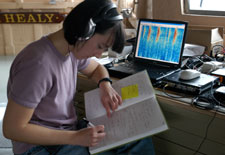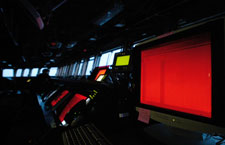 |
 |
 |
| Crushed by the weight of the Arctic Ocean, these styrofoam cups have shrunk to a fraction of their size. |
Click
to enlarge
|
 |
 |
| A red wind pennant
flutters in the breeze. It helps the bridge crew determine the
wind direction. |
Click
to enlarge
|
 |
 |
| Lisa Munger listens for whales. |
Click
to enlarge
|
 |
 |
| The bridge at night. |
Click
to enlarge
|
Daily Update
Calendar
Dispatch 35 - October 14, 2003
By C. A. Linder
Weather conditions: Overcast skies, intermittent snow flurries,
15 kt winds, 1-2 ft seas, air temperature 30°F
Eddy Hunting
The darkness is slowly closing in on us, little by little, day by
day. This morning the first rays of sunshine didn't brighen the
horizon until 10AM. The sunlight briefly touched some high clouds,
turning them peach and magenta. More
snow flurries whipped around the ship today as we steamed on a new
track, this time along the shelf edge.
We have turned east on a new mission - we're tracking eddies. Eddies
are large, circular (10-15 miles across) blobs of water that spin
as they move. These eddies are carrying water from the shelf into
the deep basins. Since one of the main objectives of this project
is to study this complicated exchange process, we want to know how
many eddies there are and where they're going. We can determine
this by measuring the water temperature - the eddies are slightly
warmer than the surrounding water.
This question comes from Ryan and Stephanie. They
are in Mrs. Lyons' 5th grade class at Mt. Alvernia Academy.
Question from Ryan and Stephanie: What is the atmosphere
and climate like in the Arctic?
Answer: Hi Ryan and Stephanie. The Arctic climate
is very different from what we're used to in the temperature latitudes,
and the biggest difference is that it's always cold!
There are a number of reasons why the Arctic remains cold, even
in summer. At high latitudes (both the Arctic and Antarctic), the
sun is always low on the horizon. The sun's rays hit the earth at
a very shallow angle. Thus, the sun's energy needs to pass through
more atmosphere to get to the ground. Lots of that energy gets absorbed
along the way. In addition, since snow and ice surfaces are very
reflective, very little of the energy that reaches the ground stays
there. All of these things contribute to the cold temperatures we
are experiencing here in the Chukchi Sea.
In addition to being cold, the Arctic is also very dry. In fact,
the only part of North America that gets less moisture is the desert
southwest! This is due in part to the fact that colder air can hold
less moisture than warm air. In essence, in winter it is too cold
to snow. The snow flurries we have seen on the ship have been very
short, and the snow has been very powdery. The accumulation on deck
has been less than an inch over the whole cruise.
Two different air masses influence Arctic climate: polar maritime
(influenced by the ocean) and continental (influenced by large land
areas). The ocean influences the climate in the Arctic just like
it does in temperate latitudes. For example, when it is 80°F
in Boston it is typically only 70°F on Cape Cod - the air near
the Cape is moderated by the colder Atlantic Ocean water. Conversely,
in winter the ocean is warmer than the land, and the ocean warms
up the atmosphere. Since the Arctic region is dominated by the Arctic
Ocean, the polar maritime climate subtype is the primary climatic
influence. This air mass brings cold, stormy winters and mild, cloudy
summers. The interior of the large countries surrounding the Arctic,
such as Siberia and Canada, are primarily affected by a continental
polar air mass. Just like New Hampshire and Vermont, they have harsher
winters and hotter summers than the coastal regions.
Tonight we'll be moving fast along the shelf deploying expendable temperature
probes called XBTs. They allow us to measure the temperature very quickly, since
we don't have to stop the ship to deploy them - you just drop them over the side. The data is fed back to the ship via a thin wire. We are hoping that these temperature measurements reveal the locations of the eddies along the shelf.
 Previous
Dispatch
Next Dispatch Previous
Dispatch
Next Dispatch

Back to
Calendar
|




